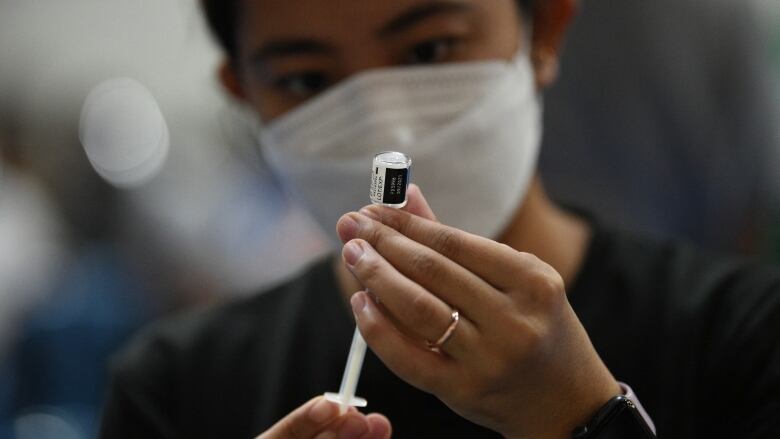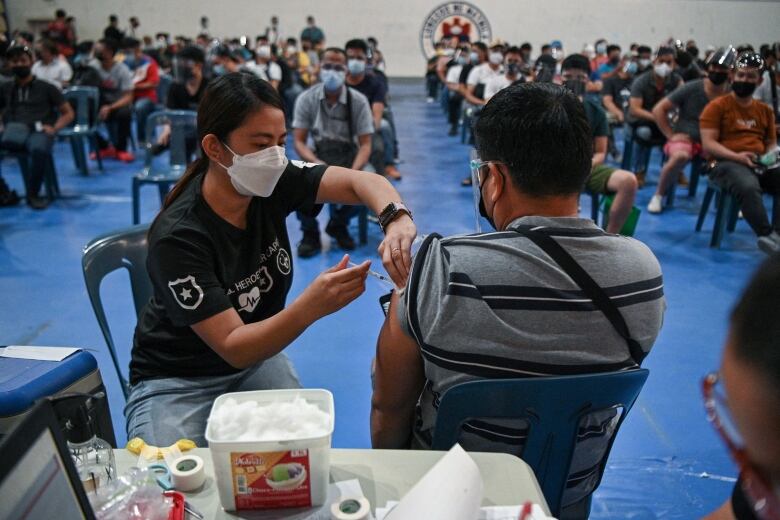Yes, vaccines curb COVID-19 transmission but that's not enough to protect those without a shot
Variant cases, hospitalizations surging globally in regions with lower vaccination rates

This story is part of Second Opinion, a weekly roundup of health and medical science news emailed tosubscribers every Saturday morning. If you haven't subscribed yet, you can do that by clickinghere.
Even as highly contagious coronavirus variants are circulating, virologists and immunologists say leading vaccines are not only preventing serious infections but likely curbing transmission as well.
However,that doesn't mean the vaccinated can fully protect the unvaccinated totalling billions of people globally particularly in areas with lower vaccination rates.
"Most vaccines are working very efficiently to prevent onward transmission from the vaccinated infected person to a non-vaccinated person," said Akiko Iwasaki, a professor of immunobiology at Yale University's school of medicine.
In various countries where vaccination efforts are rolling out widely, there are some other clear trends emerging: severe cases of COVID-19 are going down as vaccination rates go up;"breakthrough infections" among fully vaccinated individuals remain rare and typically mild;and cases of serious illness leading to hospitalization or death are now largely appearing among unvaccinated populations.
Itall backs up the protective power of this first crop of vaccines at a time when much of the world is reopening, including Canada.
But with so many unvaccinated people around the world,and because of the transmissibility of variants such asdelta, this virus keeps on spreading, Iwasaki said.
"The whole concept behind herd immunity is to provide that protection in the unvaccinated people by having enough vaccinated people around them," she said.
"But I think we can't be complacent, because that kind of herd immunity really requires large numbers of people to be vaccinated within a given population. And many places have not achieved that yet."

Few COVID-19 cases among fully vaccinated
In Canada, COVID-19 cases have dropped sharply in recent months, and data shows only a small percentage of those are among fully vaccinated Canadians.
But with more than half the population not yet fully vaccinated, millionsremain at risk of getting infected.
While several experts who spoke to CBC News say vaccinated individuals are helping to curb transmission to those not yet protected, the precise mechanism behind why COVID-19 vaccines are likely reducing transmission isn't entirely clear.
Angela Rasmussen, a virologist with the University of Saskatchewan's Vaccine and Infectious Disease Organization, said vaccines act less like a wall or shield that totally blocks a virus from entering your body, and more like a complex army that fights it off once those invaders arrive.
For example, she said, imagine someone coughing in your face. You're going to inhale some virus particleswhether you're vaccinated or not. But for those protected by a vaccine, it's what happens next that makes the difference.
WATCH | Vaccination ratesslow down in U.S. as case numbers rise:
Vaccinated individuals' immune systems are fighting off the virus faster, giving it few opportunities to replicate, and minimizing any symptoms such ascoughing or sneezing that would help pass it on, Iwasaki said.
"Those kinds of activities, we know, propel and expel the virus much better than if you're just breathing," she said.
Since fully vaccinated individuals are typicallyable to clear the infection so quickly, it's "incredibly unlikely" they would ever be producing enough virus to infect others, Rasmussen said.
More research needed to gauge impact on transmission
While those are the principles behind how vaccines can prevent both infection and transmission, actually getting real-world data to determine exactly how much they're curbing the virus's spread is tricky, Rasmussen said, with more research needed as SARS-CoV-2 keeps evolving.
The team behind one recent study on vaccine protection in Israel acknowledged the challenges, saying their research had several key limitations. Individual behaviour, policy decisions such aslockdowns, and factors such as post-infection immunity all playeda role in muddying the waters making it harder to figure out just how much vaccines were stopping the virus's spread.
Still, after factoring all that in, the researchers did find "observational evidence that vaccination not only protects individuals who have been vaccinated but also provides cross-protection to unvaccinated individuals in the community," according to their peer-reviewed briefing note in a June issue of the scientific journal Nature.

The team analyzed vaccination records and test results collected during a rapid vaccine rollout in 177 communities, and found the rates of vaccination in each area were associated with a later decline in infections among unvaccinated youth.
"On average, for each 20percentage points of individuals who are vaccinated in a given population, the positive test fraction for the unvaccinated population decreased approximately twofold," the researchers wrote.
Another recent study from Public Health England, which was published as a correspondence in the New England Journal of Medicine last month, found that three weeks after people received a single dose of either the Pfizer-BioNTech or AstraZeneca-Oxford vaccine, household transmission of the virus was reduced between 40 and 50 per cent.
WATCH | Saskatoon ICU doctor describes regret of dying COVID-19 patient who didn't get vaccinated:
Virus spreading thanks to variants
But while vaccinated individuals may be helping to protect those who haven't received their full set of shots, those efforts only go so far.
Throughout much of Africa, where vaccination rates are among the lowest in the world, variants such asdelta, alphaand beta are spreading rapidly, spiking infection rates and putting pressure on various countries' hospital systems.
Across the entire continent, there has been a 43 per cent week-on-week rise in COVID-19 deaths, the World Health Organization said on Thursday, withat least six countries now facing shortages of intensive care beds.
"We need to really get things clamped down soon, because the simple fact is that areas that may have actually had somewhat of a reprieve from the pandemic thus farare now getting hit very hard," said Jason Kindrachuk, an assistant professor of viral pathogenesis at the University of Manitoba.
"South Africa is a perfect example where they've got low vaccine coverage. This is the most prosperous nation in Africa, and they already were hit by the gamma variant, now they're being hit again by delta."
The delta variant, which is thought to be significantly more transmissible than other widely circulating variants and the original strain of SARS-CoV-2, is also taking hold even in highly vaccinated countries such asIsrael, the U.K., the U.S., and in Canada, where it now makes up close to 75 per cent of cases in Ontario alone.
However, in all those countries, daily deaths dropped significantly since vaccination efforts began.

Unvaccinated 'driving transmission'
Yet pockets of unvaccinated individuals remain be it because of eligibility, hesitancyor a lack of access and there's a stark split in how this virus is now impacting people's lives, with unprotected individuals bearing the brunt of its spread.
In the U.S., for instance, nearly all COVID-19 deaths are now among those who aren't fully vaccinated, according to an Associated Press analysis.
And there are growing fears that rising case counts in states with low vaccination rates such as Missouri, Arkansas, Nevada, Louisiana and Utah could be a harbinger of more hospitalizations and deaths in those specific regions, even if the U.S. as a whole wards off a massive spike.
"If there's a significant proportion of people who are not vaccinated and this is exactly what we're seeing in the United States those are going to be the people primarily driving transmission, those are going to be the majority of the cases, those are going to be the vast, vast majority of the hospitalizations and deaths," Rasmussen said.
LISTEN |What can the rest of Canada learn from the wave of COVID-19 in Yukon?
It's a similar situation in Canada as well.
In Saskatchewan, theCOVID-19 patientsrecently admittedto the province'sICUshave beenoverwhelmingly unvaccinated. In June, 15 people died from the virus, and officials saidnone of them were fully vaccinated.
A gamma variant-fuelledoutbreak that has swept through heavily vaccinated Yukonalso offers a cautionary tale. As of June 6, the territory had recorded under 90 cases, but that hassince spiked to more than 460the largest outbreak the North has experiencedand they're largely among those who haven't been fully vaccinated.
Spotty vaccine coverage could mean these disparities continue in the months ahead, said Kindrachuk, because communities with lower vaccination rates "don't have that protective buffer" against more transmissible variants even if overall vaccination levels tick up.
"Ultimately, the vaccines have been working very well," he said.
"It's more a question of, how can we get these globally distributed to the areas where we're seeing high transmission and reduce that toll?"
With files from Adam Miller, CBC News















_(720p).jpg)


 OFFICIAL HD MUSIC VIDEO.jpg)
.jpg)



























































































